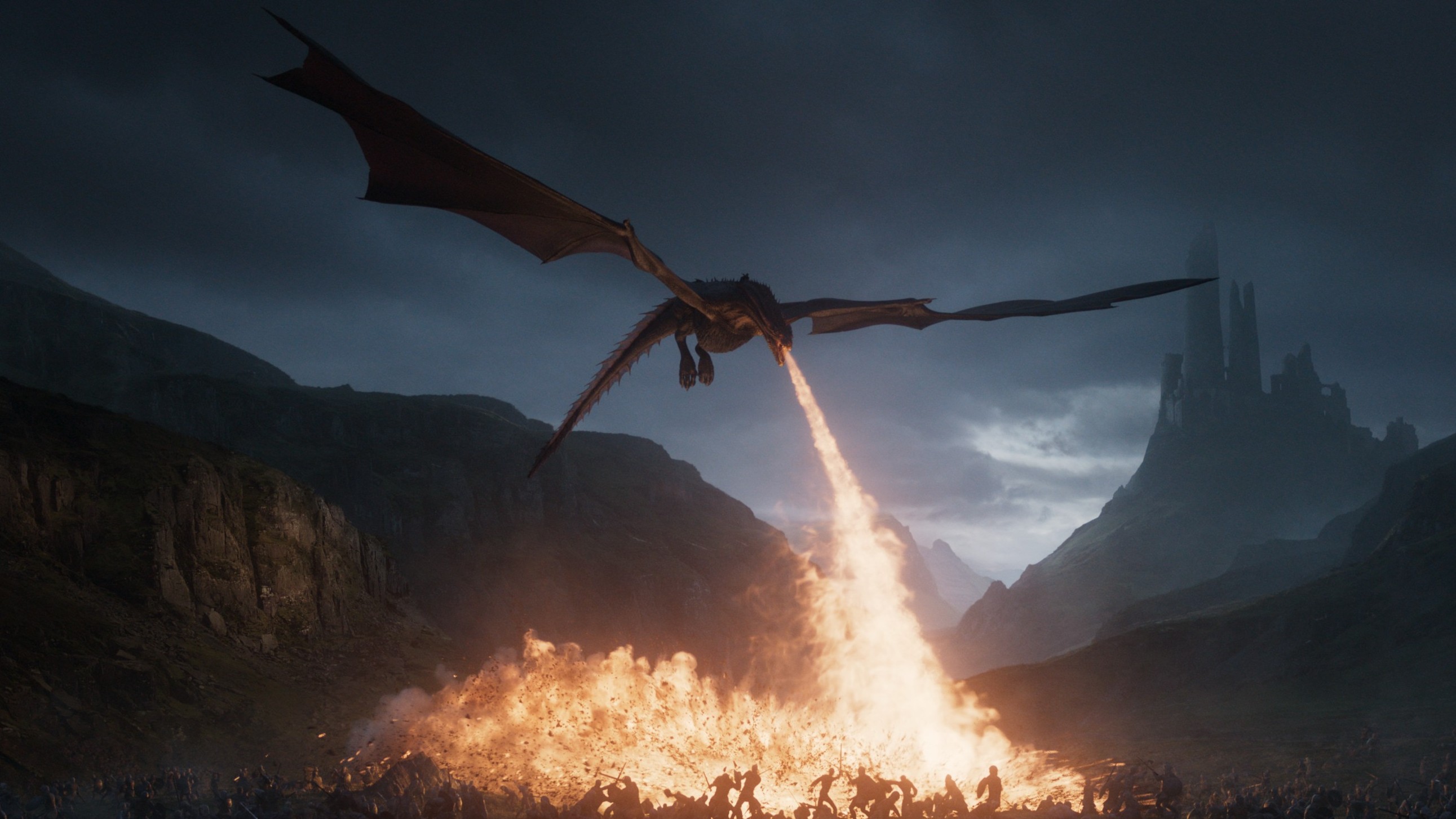
Horizon Call of the Mountain knows what its job is: to ride the popularity of Horizon Forbidden West and spearhead Sony’s new foray into virtual reality gaming, the PlayStation VR 2. It really goes for it by placing less of a focus on the expansive story of Forbidden West and much more on spectacle, often wowing with the sights it places in front of you. On that level it’s a remarkable technical showcase that lets you have a good deal of excitement when taking the handbrake off and handing you control of its exhilarating combat. It’s therefore a slight shame that it often operates at a much more relaxed pace, which does allow you to frequently take in the beauty of its world, but prevents itself from thrilling consistently from start to finish. When it does all click, though, and those heights are hit, a very fun time is there to be had.
Similarly to how a Disneyland ride borrows from whichever film it’s based on, Call of the Mountain takes the Horizon experience and condenses it into something much more bitesize while trying to keep the same flavour. This is exemplified best by the Pirates of the Caribbean-like opening, in which your peaceful river cruise is rudely interrupted by the likes of a soaring Stormbird and towering Tallneck dino-bot. It’s a real credit to the work that developer Firesprite has done in translating Guerrilla’s original art design into something more impressive than any TV screen could do justice to – both in the stunning vistas this world offers and the trademark machines that populate it.
The first time you see the scale of some of these creatures really is a sight to behold, not only from the shift to true first-person perspective emphasizing their true size, but with their presence felt further thanks to the haptic feedback felt both in each controller and the headset itself: as you quite literally feel the ground shake with every step as these massive machines pass by. It’s a real showcase for the PS VR2 right off the bat, with huge spectacle blending with small detail – right down to the delicate ripples your fingers make in the water and the rude splashes made by the feet of giant machines.
Blockbuster opening aside, over the course of its roughly six-hour campaign Call of the Mountain takes the essence of Horizon’s gameplay and boils it down into a much more manageable set of tools that works in VR. Rocky landscapes to explore, hostile machines to take down, puzzles to solve – it’s all here. What’s notable, however, is that this is very much a linear experience that stands in sharp contrast to Zero Dawn or Forbidden West’s vast open worlds. An inquisitive mind is occasionally rewarded with fun side activities, such as stacking rock cairns or collectible archery targets to hit, but mostly you’ll be guided down a funneled path. This narrow approach naturally works well in VR, even if some of the inherent exploration that Horizon normally offers is lost.
If you suffer from any level of vertigo, this may not be the game for you.
There are two movement options to choose from: a “gesture”-based system that moves you around when holding two buttons and imitating a walking motion with your arms, and a more traditional analog stick-based system. After trying both I opted for the former for most of my playthrough, despite both coming with their pros and cons. At first, the gesture system didn’t strike me as overly intuitive, but once I got to grips with it I preferred it simply because it made me feel far less nauseous when playing for long stretches (by which I mean about 30 minutes). I did, however, find myself switching to the analog sticks whenever entering combat, as the dodge mechanics associated with this moveset (a flick of the right stick) made for a much easier time. Everyone’s mileage on this will obviously vary based on your VR tolerances, so I’d recommend trying out both to see which suits you best.
Now’s the time to say that if you suffer from any level of vertigo, this may not be the game for you. I’m not too terrible with real heights, but here I did start to feel a little queasy when looking down at some of the ludicrous distances I could fall from. There are quite a few opportunities for potential plummets as well, thanks to the sheer amount of climbing you’re asked to do. Climbing cliffs. Climbing vines. Climbing ice walls. Climbing rock faces by lodging dual pickaxes into them. Almost so much climbing that you may find yourself wanting to climb the walls of your house as well.
Now, I wasn’t naive enough to think that a game called “Call of the Mountain” wouldn’t involve some climbing, but I was taken somewhat off guard when I found that it really is the majority of what you’ll be doing here, especially in the early hours. Climbing isn’t overly challenging, but honestly reaching for handhold after handhold gets quite dull after you’ve scaled your third or fourth outcrop. It does get slightly more interesting once tools such as the grappling Grabcaster are introduced, and the immersion of it all as the wind swirls around your ears and the excellent music swells as you reach the next peak is undeniable. Although some ascents offer slightly more excitement than others, I can honestly say I never found climbing to be consistently fun. It’s frustrating then, that it dominates much of what you’ll be doing in Call of the Mountain, in particular when compared to its much less frequent but infinitely more exciting combat sections.
Largely taking place in mini arenas, these gladiatorial battles against all manner of unfriendly machine are often the highlight of each mission. It’s where the immersion of it all really beds in as you briefly forget what era of Earth you’re living in and the rhythm of combat takes hold. Armed with the signature Horizon weapon of a bow and arrow, you’ll quickly find yourself aiming for enemy weak points using the PS VR2’s impressive eyeball tracking tech, and then quick-dodging out of the way of flying melee attacks before ducking and weaving your head out of the way of projectiles.
It’s a set of combat options that gradually builds over time as well, as new ammo types are introduced and your arsenal expanded. As stronger foes present themselves, naturally more firepower is needed, and with it the levels of excitement to find increase – a thrilling fight against a colossal Thunderjaw being a particular highlight. Preparing yourself for encounters becomes increasingly more important as you build all sorts of elemental arrows in a pleasing crafting system that lets you manually attach arrowheads, explosives, and flights, thus further creating a tangible connection to the world.
More gratifying than crafting arrows though is, of course, firing them – and in this regard Call of the Mountain has really nailed it. Now, my real-world archery experience may only stretch as far as giving it a go when 11 years old on a school trip, but in my expert opinion this feels pretty damn good. There’s a real pleasing “ping” to the way each arrow flies off of the bowstring and haptic feedback tickles your palm, and then an even greater thrill as it slams into whatever is unfortunate enough to be in its way and sets them aflame thanks to explosive Blaze. Unlike the climbing, it just never gets old to watch sparks fly and machine parts fall off as the fundamentally brilliant Horizon combat successfully makes its way into the virtual reality space.
It’s a highly satisfying cadence that works really well in VR thanks to its enthralling but never overwhelming speed, but is also forgiving if you happen to get blindsided by a roaming Scrapper, for example. If you do manage to take some damage you can find a pocket of peace amongst the mayhem by going for a snack break and refilling your health bar by munching on some fruit. A health bar is smartly located on one of your hands (much like we saw in Half-Life: Alyx) meaning it’s never more than a quick glance away, like checking the time on a watch, and always in view when aiming down sights. All in all, the interface of Call of the Mountain is very cleverly implemented, making it feel like a tangible part of your character and not a series of distracting floating boxes that threaten to take you out of the beautiful world.
The fundamentally brilliant Horizon combat successfully makes its way into the virtual reality space.
Puzzles also pop up here and there and, again, serve as a welcome break from climbing. Did I mention there’s a lot of climbing? The problems are sometimes fun but never overly difficult, and once the novelty of actually physically picking up gears and slotting them into position myself wore out they became yet another minor obstacle on the way to the next combat encounter or story moment.
That story is serviceable, but one that is definitely engineered in order to facilitate big moments and fun cameos rather than tell a layered tale itself the way the previous two Horizons have. Here you play as Ryas rather than Aloy – he’s a Shadow Carja rebel who must complete a series of tasks in order to atone for his crimes. His internal monologues are mercifully limited in a smart maneuver that allows you to experience this world first-hand yourself and not be distracted by voices in your head.
Naturally, things escalate as the plot thickens, and the second half of the campaign becomes much more engaging than the first thanks to the action increasing in both quality and quantity. A personal highlight is the aforementioned Thunderjaw cat and mouse section, which conjures up memories of Jurassic Park at its rousing best. There are a few little nods scattered throughout for big Horizon fans to find of value here – familiar faces like Aloy drop in to say hello – but don’t necessarily come in expecting a dense new chapter in this universe’s lore.
Outside the main story you’re free to explore your small home base, take a closer look at artifacts collected on your expeditions, and chat with friends made along the way. It’s also home to the pleasant safari mode: a largely tranquil alternative version of the opening boat cruise which shows off a selection of the Horizon bestiary in its natural habitat. It’s short, sweet, and a reflection of the Disneyland-like nature of Call of the Mountain as a whole – an impressive technical showcase for PS VR2 which uses the inherent wonders of the Horizon world to sprinkle thrills into its sometimes-lazy river ride.




